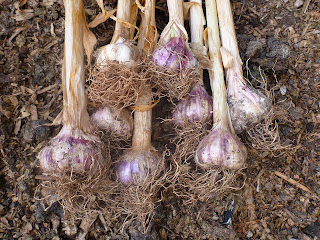Fight the Blight
This is a critical time of year for anyone growing potatoes or tomatoes. If we have a humid period in summer the dreaded late blight or 'potato blight' (Phytophthora infestans) can wreck your entire crop.
This fungal disease was in part responsible for the Irish Potato Famine between 1845 and 1852, which killed over 1 million people and forced the emigration of a million more. This event has such cultural and political significance in Ireland's history that you will still find a potato blight warning when conditions are conducive on Met Éireann. It's so devastating to humankind that during the 1940s and '50s, Phytophthora infestans was even investigated as a biological weapon by a number of countries!
Modern growers can fight back by growing a variety of different crops, growing disease-resistant strains, growing early varieties and keeping a watchful eye for tell-tale early signs of blight. This means that blight is unlikely to cause a famine today. But, it's still a real threat, and farmers using non-organic methods can protect their crops with a powerful anti-fungicide spray of metalaxyl and carbamate. If infection does occur, the leaves and stalks are burned off with powerful weed-killer or sulphuric acid to save the tubers! Even organic farmers are allowed to use copper sulphate if a major threat exists.
Home gardeners usually make do with quick intervention, removing all leaves from the plant when blight occurs - effectively bringing an end to the potato growing season before the tubers are affected. Similarly, tomatoes can be picked green and ripened off the plant before blight enters the fruit.
If blight conditions are prevalent, there is an entirely natural anti-fungicidal spray you can make from garlic which is safe to use around the allotment. It also kills aphids and other pests. Co-incidentally, this time of year sees the first garlic being lifted and in my case I still have some less than perfect bulbs left from last year. So, here's what to do with those bulbs you've either saved or decided are too soft to store this year:
Items needed
Method
Variations
Most importantly, keep an eye and ear out in the local area to identify if blight is on its way. If we hear anything we'll tell you on the blog.
This fungal disease was in part responsible for the Irish Potato Famine between 1845 and 1852, which killed over 1 million people and forced the emigration of a million more. This event has such cultural and political significance in Ireland's history that you will still find a potato blight warning when conditions are conducive on Met Éireann. It's so devastating to humankind that during the 1940s and '50s, Phytophthora infestans was even investigated as a biological weapon by a number of countries!
Modern growers can fight back by growing a variety of different crops, growing disease-resistant strains, growing early varieties and keeping a watchful eye for tell-tale early signs of blight. This means that blight is unlikely to cause a famine today. But, it's still a real threat, and farmers using non-organic methods can protect their crops with a powerful anti-fungicide spray of metalaxyl and carbamate. If infection does occur, the leaves and stalks are burned off with powerful weed-killer or sulphuric acid to save the tubers! Even organic farmers are allowed to use copper sulphate if a major threat exists.
Home gardeners usually make do with quick intervention, removing all leaves from the plant when blight occurs - effectively bringing an end to the potato growing season before the tubers are affected. Similarly, tomatoes can be picked green and ripened off the plant before blight enters the fruit.
If blight conditions are prevalent, there is an entirely natural anti-fungicidal spray you can make from garlic which is safe to use around the allotment. It also kills aphids and other pests. Co-incidentally, this time of year sees the first garlic being lifted and in my case I still have some less than perfect bulbs left from last year. So, here's what to do with those bulbs you've either saved or decided are too soft to store this year:
Items needed
- Garlic - lots of it
- Water
- A bucket
- Garlic crusher
Method
- Extract garlic cloves from the bulbs
- Crush (or use a blender with a little water)
- Add 1 - 2 litres of water for every bulb used
- Let it infuse for at least an hour. You can leave it overnight.
- If using in a sprayer, you will need to filter/sieve out any solids
- Use on your plants before and during a possible blight attack
Variations
- Some people add a teaspoon of baking soda to the mix
- Some simmer the brew in a saucepan for a while - this aids oil extraction
Most importantly, keep an eye and ear out in the local area to identify if blight is on its way. If we hear anything we'll tell you on the blog.
Submitted by Tigger

Comments
Post a Comment